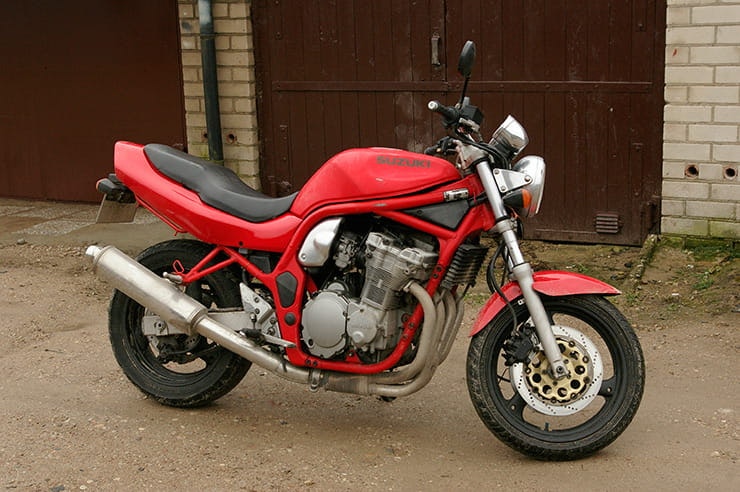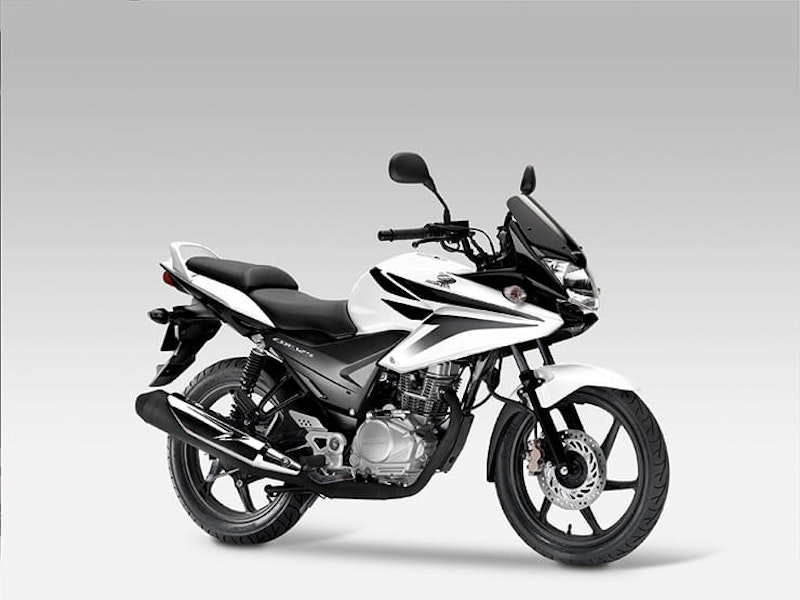Top 10 most popular bikes in the UK
By Phil West
Freelance journalist/editor/author
12.09.2017
We take a look at the most popular bikes in the UK, according to top motorcycle insurer, Bennetts:
SUZUKI GSF 600 N BANDIT - 1995-2007
The original Bandit was launched as a naked roadster but was quickly joined by a half-faired version and proved so successful it not only lived on through two further reincarnations to 2012 (although from 2007 it was a 650) and spawned a whole new class (budget middleweight fours created out of older sports bikes) including the likes of Yamaha’s Fazer 600 and the Honda Hornet.
Based around the 16-valve, oil-cooled four from the GSX600F, it produced 77bhp at 10,500 (lacking for a sportster but ample for a roadster), was straightforward, easy and pleasing to ride and versatile but best of all, it was, and remains, brilliant value for money.
HONDA CBF 125 - 2009-2015
Air-cooled, fuel-injected, four-stroke, single-cylinder commuter was launched as the successor to the long-lived CG125. As such the CBF is simple and straightforward but benefits from more modern styling, including snazzy, frame-mounted half-fairing, plus more contemporary equipment such as a front disc brake, alloy wheels and improved instrumentation. In being impressively cheap and hugely economical (it’s easily capable of 100+mpg) the CBF was also unsurprisingly very popular, even though its build quality wasn’t the best with instances of rust showing through the black exhaust paint after only a few months’ use. The CBF has since been replaced by the Euro4 compliant CB125F.
SUZUKI SV 650 S | 1999-2004
In the late 1990s Suzuki launched a series of liquid-cooled, V-twins roadsters with mixed success. But if 1997’s TL1000S gained a reputation as a widow maker and ’98’s TL1000R conspicuously failed in WSB, 1999’s SV650, available as both a naked roadster and, in ‘S’ trim, as a half-faired sportster, was an immediate success – so much so that it lives on in third generation form today. The 645cc V-twin is the star of the show: eager, flexible and free-revving fun. But the Ducati-alike trellis chassis, although budget, is a willing participant giving a perfect blend of light, novice-friendly nimbleness and sporting fun. The original SV was replaced with an updated, fuel-injected version in 2004.
YAMAHA YBR125 | 2005-2016
This bog-basic, air-cooled, four-stroke, single-cylinder roadster was launched as Yamaha’s commuter rival to Honda’s CG/CBF125 and mirrored most of that bike’s specification, abilities and success. The YBR may be basic and unexciting but it’s also light, a doddle to ride and, in being good for almost 100mpg, provides brilliantly cost-effective travel – hence its popularity. A custom version based on the same 10bhp powertrain was also launched in 2008 and proved an equally effective city bike for those preferring a more laid back posture. Both fell foul of Euro4 regulations and were replaced in 2017 by Yamaha’s updated YS125.
HONDA CBR 900 RR FIREBLADE | 1992-2003
Honda’s game-changing superbike exploded into motorcycling in 1992 and proved so dynamic, exciting and popular it changed the direction of all superbikes which followed thanks to its emphasis not on brute power but on light weight and compact proportions. Six distinct models were created by the legendary Tadao Baba’s team until he retired and a new, MotoGP-alike 1000cc version took over in 2004. The original, 124bhp, 185kg ’92-’93 N/P models are now collector’s items, as is the succeeding, facelifted, ’94-’95 ‘Foxeye. The ’96-’97 T/V went to 918cc and 128bhp while the ’98-’99 W/X, although now producing 130bhp, was totally overshadowed by Yamaha’s new R1. Both, as a result, can still be used bargains. 2000’s 929cc Y/1 version went back to basics and is sharper all round while the great-looking and classy 2002/3 ‘954’ is also fast-approaching modern classic status, too.
YAMAHA FZS 600 FAZER | 1998-2004
Yamaha’s response to the hugely successful, budget-priced, GSF600 Bandit, copied Suzuki’s ‘parts-bin’ approach in using an existing supersport engine (in this case a detuned, restyled version of the Thundercat’s 599cc four) in a cost-conscious, tubular steel frame. Yet the new Fazer aced the Bandit by being better equipped (only a racy-looking, twin headlamp version was offered), faster (the Fazer put out 95 horses compared to the Bandit’s 77) and had better brakes and handling too – yet all still for budget money. The result was so successful it lived on for six years, with minor updates coming in 2000 (larger tank, clock and fork preload adjusters added) and a more substantial restyle in 2002.
TRIUMPH SPEED TRIPLE | 1994-2017
British three-cylinder naked was originally launched as an unfaired 900 Daytona in 1994 and proved such a hit it’s lived on ever since, become a mainstay of Triumph’s range and evolved through seven full incarnations. The classic template was set, however, with the bug-eyed, twin headlamp, single-sided swingarm T509 of 1997, which was a spin-off of that year’s all-new T595 Daytona sportster. Since then it’s evolved into the 10bhp-boosted, 118bhp 955 of 1999, the slightly restyled and fuel-injected 120bhp 955i of 2001, before the Daytona variant was dropped completely and the Speedie lived on as the new, stand alone, aggressive, 130bhp Speed Triple 1050 of 2005. This was then updated further in 2008, restyled with new angular lights in 2011 and fully-updated into the 140bhp R and S versions in 2016. It may longer be a true naked sportster, but as a fun-packed, characterful roadster, there’s none better.
SUZUKI GSF 1200 BANDIT | 1996-2006
Suzuki followed up the instant success of the GSF600 Bandit in 1995 with a bigger brother the following year – 1996’s GSF1200 Bandit that, like its junior sibling, came in both naked (N) and half-faired (S) forms. Like the 600, the 1200 was a budget, ‘parts-bin’ roadster with a tubular steel frame but was this time based around a detuned, 100bhp version of Suzuki’s monster 1152cc, GSX-R1100 oil-cooled four. The result is similarly easy and versatile dynamics but in an all-round larger and heavier package yet one with oodles of creamy grunt. The faired version has always made a decent, bargain-priced all-rounder. The naked is a fave with streetfighter fans. Both were superseded by a new liquid-cooled 1250 in 2007.
HONDA CBR 1100 XX SUPER BLACKBIRD | 1997-2005
Superfast, hyperbike sports-tourer designed at the height of the ‘speed wars’ between the Japanese manufacturers in the mid-to-late ‘90s to both claim the world’s fastest production bike crown and deliver superlative mile-eating ability. Typically Honda, it delivered profoundly on both counts. Its FireBlade-derived 1137cc four produced a gob-smacking 164bhp (nearly 20 more than Kawasaki’s then reigning ZZ-R1100) while radical aerodynamics helped it to 176mph and a speed crown it held for three years. Chassis competence and luxurious fittings, meanwhile, gave it great versatility and true flagship status. Updated with fuel-injection and a larger tank in 1999 it remains a prized and valued machine to this day, and one that Honda has yet to successfully replace.
TRIUMPH SPRINT ST | 1998-2017
This three-cylinder sports-touring rival to popular all-rounders such as Honda’s VFR800 has gone through two major incarnations since its launch and had proven a dogged, practical bike with a loyal following. The 1998 original was a fully-faired, more relaxed spin-off of Triumph’s then Daytona T595 sportster, produced a detuned 110bhp and was launched alongside a slightly sportier, half-faired Sprint RS. The RS was dropped in 2003 with both bikes being replaced by an all-new Sprint 1050, based around updated Speed Triple 1050 mechanicals, in 2005. Distinguished by its angular styling and underseat exhaust this version, producing 123bhp and featuring multi-adjustable suspension was briefly a class-leader but, being last updated with a longer swingarm in 2010 into ‘GT’ form is now aging a little.

